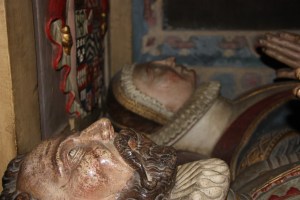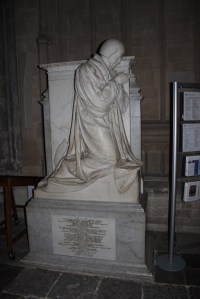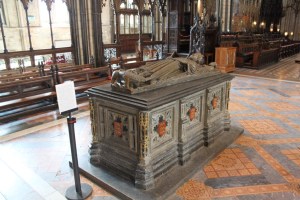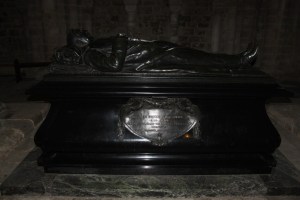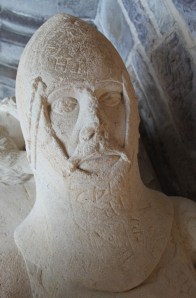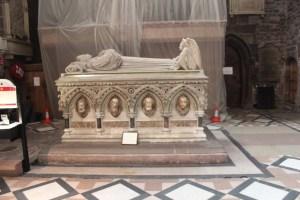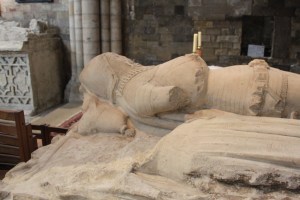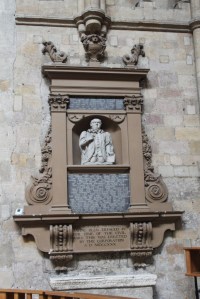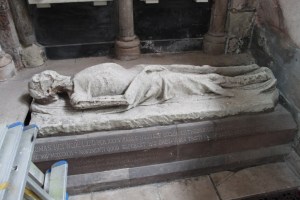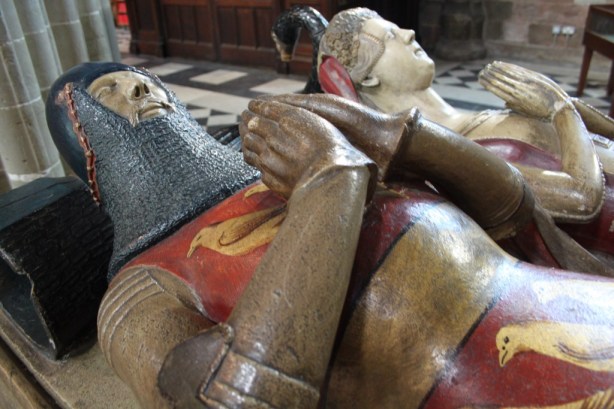
Medieval Lordly Tomb, Worcester Cathedral
From Howard’s Archaeodeath blog.
Here are some very basic musings about tombs in cathedrals prepared for the Speaking with the Dead exhibition at Exeter Cathedral. Church monument experts: expect to find errors and happy to be corrected and additional examples pointed out.
Introduction
Effigy tombs are complex, varied, striking and prominent monuments to the elite dead which can dominate even the largest of cathedral churches. These space-gobbling monuments can be placed in wall-niches or free-standing within cathedral aisles, chapels or transepts. They are among the most interesting to visitors and most commented upon monuments for any cathedral.
These are body-centred monuments. Effigy tombs (and effigy slabs) depicted the dead in prayer or holding artefacts that denote their office and identity. The sculpted bodies wore costumes befitting the deceased’s status or rank held in life and that aspired for recognition in Heaven.
Recipients of effigy tombs included archbishops, bishops, abbots, deacons and priests. For the secular elite: royalty, nobility, gentlefolk were sometimes joined by lower social classes.
Effigy tombs were created to commemorate the dead as animate souls, upon chest tombs, elaborate canopies above. The body is in repose, not asleep and certainly not dead. Originally, they were depicted in rich polychrome to give a life-like appearance.
Angels, saints, heraldic beasts, canine companions and a range of other figures and ornament add to the variability of effigy tombs. Text is thus subordinate, wrapped around and introducing the principal corporeal focus of the tomb. Yet these are not mute stones: they speak to us and they spoke and speak to each other.
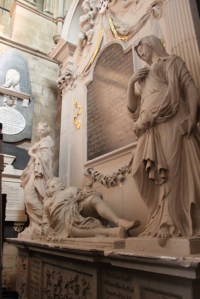
18th-century monument, Ripon Cathedral
Effigial Chronologies: Speaking over Time
Medieval effigy-slabs and tombs date from the late 12th century through to the early 16th century.
After the Reformation, both secular and ecclesiastical effigy tombs persist during the later 16th and 17th centuries. In addition the continued depiction of the dead in repose, new postures are adopted, including the dead in prayer, seated, standing or simply busts. Figural art also rises up onto the walls upon more abbreviated murla monuments.
There are 18th-century examples that depart from the formal effigial design with the deceased lying down beneath the epitaph. There are also increasingly life-size ‘mourners’; usually women but also children, angels and cherubs.
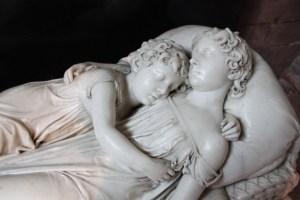
Early 19th-century effigy commemorating the lives and deaths of two young girls, Lichfield Cathedral.
Early nineteenth-century examples include the ‘sleeping children’ of 1817, a particularly sentimental sculpture from Lichfield Cathedral for two female children who died in 1813 and 1814.
Effigies find a further lease of life following the Gothic revival in the late Victorian and Edwardian periods. There are recumbent effigies of specific individuals as well as statues of mourning women and generic representations of soldiers upon war memorials. Therefore, effigies in cathedrals were designed, commissioned and installed for over eight hundred years and are phenomenally varied.
Continuous Effigies: Speaking through Time
Effigy tombs form a prominent lynchpin creating senses of continuity through the ages in cathedrals. At Canterbury there are effigy tombs for all periods, the earliest dating to the thirteenth century and the latest dating to Archbishop Randall Johnson (d. 1928).
In other cathedrals, there are huge time-gaps without effigies. For example, Exeter has a good range of medieval and early modern effigy tombs but nothing later. Here, effigies define the cathedral’s distant past. Conversely, effigy tombs from Chester and St Albans only survive from the 19th century, suggesting they are neo-medieval attempts to embed the dead in relation to imagined pasts.
In between these extremes, effigy tombs appear spasmodic constructions in some other cathedrals. At Norwich and Llandaff cathedrals, the medieval effigies are only augmented in the 19th century. Likewise, a large number of medieval effigy tombs survive at Winchester Cathedral but there is subsequently a hiatus until an early 17th-century effigy, a late 17th-century statue and then another hiatus before the construction of a series of 19th-century monuments and one early 20th-century effigy tomb commemorating General Sir Redvers Henry Buller (d. 1908).
A great spasmodic situation exists at St David’s Cathedral there is a huge time-gap between the fine collection of medieval effigies and one early modern effigy tomb, and the early 20th-century memorial effigies to Bishop John Owen (d. 1926) and the Countess of Maidstone (d. 1932). These temporal leap-frogs create different balances between continuity and discontinuity in the effigial use of cathedral space.
Effigial Ancestors
A further dimension of effigial chronologies is that many are created retrospectively, and thus speak of far older periods as active ways of creating ancestral identities in cathedral space. The 14th-century effigy to the Lord Rhys ap Gruffydd (d. 1196) in St David’s Cathedral may represent a medieval example of retrospective commemoration or else an antiquarian misattribution.
Chester Cathedral’s effigial obsession, with the exception of an early modern mural monument, was short-lived and Victorian. One effigy, for Bishop of Chester John Pearson (d. 1686), was 1863 paid for by American funds nearly two centuries after Pearson’s death.
Other effigies accrue ancestral identities through time; their lack of texts meaning that anonymous memorials acquire attributions. An effigy originally in the north transept of Norwich Cathedral has been afforded such an identity, attributed by antiquaries to the first Norman bishop: Herbert de Losinga. Likewise, at St David’s Cathedral, one effigy attributed to the famous Giraldus Cambrensis (Gerald of Wales) is legend rather than historical fact: it is more likely to be the effigy of his nephew Giraldus Fitzphilip de Barri.
Effigial Biographies: Speaking with Different Voices
The project is also interested in the biographies of individual monuments: how they took on new associations, were installed, reused, fragmented, vandalised, relocated, restored and reinterpreted. Especially those without texts acquire many speculative attributions by antiquaries and many of these ‘named effigies’ remain in guidebooks and popular accounts of cathedrals without demonstrable evidence as to their real, original owners.
Texts sometimes chart dimensions of the biographies of effigial monuments. For example the mural monument with a portrait of the deceased has a distinctive 18th century look, even though the memorial commemorates the early 17th-century merchant and mayor Hugh Ripley (d. 1637). An appended memorial plaque explains that the corporation restored the monument in 1730 following its damage in the English Civil War.
A 15th-century cadaver effigy, now separated from its now defunct owner’s tomb, has been displayed on two subsequent bases with 19th and 20th-century Latin inscriptions is now situated in the north transept of Lichfield Cathedral.
Equally interesting is this process of reattribution and reuse over time. At Exeter Cathedral, for example, there are two effigies, one in the Speke Chantry (Sir John Speke, d. 1519) and an effigy attributed to either Bishop Bartholomeus Iscarus (d. 1184) or a retrospective memorial to the Anglo-Saxon Bishop Leofric (c. 1070) in the Lady Chapel that are today the focus of votive offerings, memorial photographs and cards.
Thus tombs become foci for memorialisation long after they cease to operate as foci of memorialisation by those that knew the deceased. In this case, the identity of the deceased is largely incidental to the memory work focusing upon them.
Referencing Effigies: How Effigy Tombs Cite Each Other
A further theme is how effigy tombs reference each other in their form and their location. Sometimes this was original, at other times the associations were created long after their original installation. These ‘conversations’ between tombs can be between tombs of the same broad epoch.
A classic example of two medieval effigy tombs that ‘speak to each other’ can be found in the pairing of bishop’s tombs in the walls of the Lady Chapel at Exeter Cathedral: Bishop Branscombe (d. 1290) and Bishop Stafford (d. 1419). Likewise, pairings of bishop’s tombs in St David’s Cathedral are post-medieval contrivances; creating associations from tombs previously located outside the cathedral church. In these instances, a spiritual genealogy is created through this spatial pairing within very prominent places in the cathedral despite their deaths being separated by over a century.
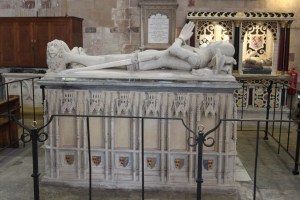
Effigy tombs ‘in conversation’. A pairing of effigies of contrasting date and original location but similar pairs of husband and wife in the south transept of Exeter Cathedral.
A comparable ‘conversation’ can be found between Victorian effigy tombs at Worcester Cathedral, and in this case this was created after each tomb was created. Again in the Lady Chapel, there are two late 19th-century effigy tombs commemorating Lord Lyttelton (d. 1876) and the Earl of Dudley (d. 1885). These are joined by a striking female effigy in prayer in a semi-upright position (Charlotte Elizabeth Digby, d. 1820).
In further instances, the conversations involve far greater time travel over the centuries and hence represent cumulative pairings or assemblages of tombs through spatial associations.
Explicit spatial relationships between medieval and post-Reformation monuments are evident in the south transept of Exeter Cathedral with its juxaposition of two effigy tombs, both to husbands and wives; the 14th-century Courtenay tomb moved here after the Reformation and juxtaposed with the late 16th-century Gilbert monument.
At Llandaff Cathedral is a similar pairing beside the high altar in the chancel between the anonymous effigy of a medieval knight, repositioned next to an effigy of a Victorian bishop, Alfred Olivant (d. 1882). In such instances it is important to remember that the Victorian effigies used the colour of the stone to create a sense of antiquity, invoking the worn medieval effigies that would have originally been richly painted in polychrome.
Conclusion
Different cathedrals in England and Wales reveal different effigial chronologies, adopted ancestors, biographies and citations, making effigy tombs operate in contrasting ways in the accrual and transformation of social memory over the long-term. It is by looking at how tombs ‘speak’ to each other, we can further understand how tombs speak to us.

‘Conversing’ effigies at Llandaff Cathedral

